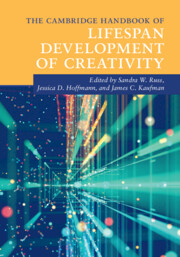Book contents
- The Cambridge Handbook of Lifespan Development of Creativity
- The Cambridge Handbook of Lifespan Development of Creativity
- Copyright page
- Dedication
- Contents
- Figures
- Tables
- Contributors
- Acknowledgments
- Introduction
- Part I Core Concepts of Lifespan Creativity Development
- Part II The Development of Creativity
- 5 Are Preschoolers Creative?
- 6 Development of Creativity in School-Age Children
- 7 The Development and Enhancement of Adolescent Creativity
- 8 The Intertwined Development of Identity and Creativity
- 9 Creative Development in Children from a Measurement Perspective
- 10 Creativity in Adulthood
- 11 The Many Faces of Creativity in Old Age
- Part III Modes of Enhancement
- Part IV Environments and Contexts
- Part V Special Populations
- Index
- References
10 - Creativity in Adulthood
from Part II - The Development of Creativity
Published online by Cambridge University Press: 19 November 2021
- The Cambridge Handbook of Lifespan Development of Creativity
- The Cambridge Handbook of Lifespan Development of Creativity
- Copyright page
- Dedication
- Contents
- Figures
- Tables
- Contributors
- Acknowledgments
- Introduction
- Part I Core Concepts of Lifespan Creativity Development
- Part II The Development of Creativity
- 5 Are Preschoolers Creative?
- 6 Development of Creativity in School-Age Children
- 7 The Development and Enhancement of Adolescent Creativity
- 8 The Intertwined Development of Identity and Creativity
- 9 Creative Development in Children from a Measurement Perspective
- 10 Creativity in Adulthood
- 11 The Many Faces of Creativity in Old Age
- Part III Modes of Enhancement
- Part IV Environments and Contexts
- Part V Special Populations
- Index
- References
Summary
Adulthood holds special promise for creativity. Not only is this developmental period the longest, but it is also the most advanced in terms of maturity of mental and biological structures people achieve. Therefore, adulthood quite naturally forms an arena for creative activities and achievements. However, creativity in adulthood does not only (or even not mainly) refer to test-measured creative potential; rather, it denotes expertise-based, mature, and, in some rare cases, eminent creativity. What are the milestones of creative development in adulthood? Why is it that so many people do not reach the level of mature creativity? What makes adults realize, or not, their creative potential, and invest their time and effort to develop it? We discuss these questions and show some new avenues for future research.
- Type
- Chapter
- Information
- The Cambridge Handbook of Lifespan Development of Creativity , pp. 206 - 232Publisher: Cambridge University PressPrint publication year: 2021
References
- 2
- Cited by



